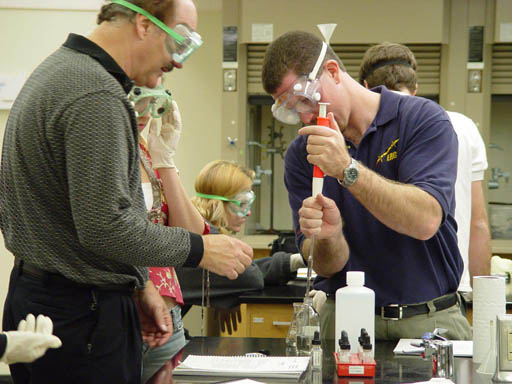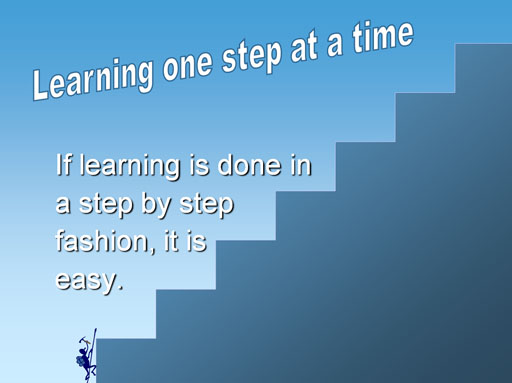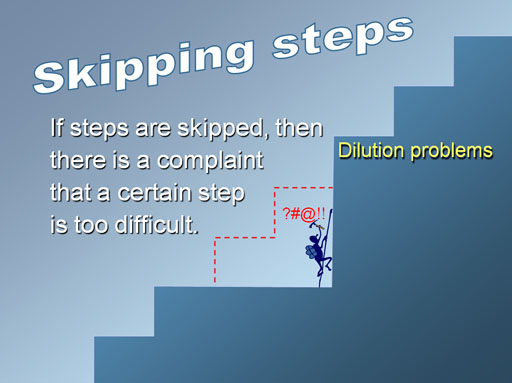SURVIVING THE PITFALLS OF LEARNING CHEMISTRY


Misunderstood Words and/or Symbols: This pitfall is the most dangerous because its effects are immediate and is the usual reason people give up on their exploration of chemistry.

Symptom: A Feeling of Disliking the Subject
Cause: Misunderstood Words and/or Symbols
If you started the class with a dislike of chemistry or if you are developing a dislike of chemistry, this indicates that you have built up a number of misunderstood words or misunderstood symbols regarding chemistry. The remedy is to find those words or symbols and get a good explanation or definition for them. When you look up the meaning of words, also try to find the origin of the word. For example, the word, valence, means "The combining capacity of an atom determined by the number of electrons that it will lose, add, or share." The origin of valence comes from Latin, valentia, meaning strength. So the word was chosen because it relates to the strength that the atom has to combine with other atoms.

Symptom: The mind goes blank
Cause: Misunderstood Words and/or Symbols
The initial reaction to a misunderstood word or symbol is the mind goes blank. Have you ever been reading a book and got to the bottom of the page and realized you don’t remember a word you just read? Very likely you came across a misunderstood word and your mind blanked out. I have witnessed students reading a paragraph out loud, and when they came to a misunderstood word, they skipped right over it and didn't even realize that they had skipped it. Their mind just went blank when they saw it. If that happens to you when studying chemistry, back up and find the misunderstood word or symbol.

Symptom: Irritated, impatient, distracted
Cause: Misunderstood Words and/or Misunderstood Symbols
Once your mind disconnects from the subject matter due to misunderstood words, you find yourself growing more impatient, irritated, or distracted. Even little things annoy you. If this happens, go back and find the misunderstood words and learn their meanings.

True Story about symptom of being irritated and impatient: Student storms from class
I once had a student who got up during a class and threw his textbook into the trash can and walked out the door. (The image is of a girl, but he had the same look on his face) Some instructors may have thought this student had behavior problems or hates the teacher or the class. My first assumption was that he had just encountered some misunderstood words. I grabbed the textbook out of the trash and ran outside to ask the student if he would just tell me what page he was on in the textbook. He showed me the page and I quickly looked it over for words that I thought could be misunderstood. I found two and asked if he knew what they meant. He didn't, so I gave him the meaning of the words. After that he was just fine and returned to the class with no problems.

Symptom: Feeling of being dumb and not belonging
Cause: Misunderstood Words and/or Symbols
Have you ever been with people who started using words that you didn't know what they meant? You can feel pretty dumb and also feel you don't belong in the conversation or even in their presence. In the image to the left the guy in the middle is caught between a couple of people using words which he has no idea what they mean. These misunderstood words can make people feel dumb, incompetent, and more critically feel they need to get away. An instructor who uses a lot of words that students misunderstand is the quickest way to get students to drop a class. Using words that people don't understand or hearing words that people don't understand is a sure-fire way to get people to scatter in opposite directions. (By the way, the guy on the left is talking about specific types of sounds heard in the lungs of someone who has breathing problems. The woman is naming certain heartbeat sounds which indicate problems with the heart and valves. If the middle guy had a few minutes to learn these words, his whole attitude would be different.)
LACK OF REALITY: This pitfall makes a big difference whether you are learning the subject superficially versus with depth. This pitfall also makes your exploration of chemistry boring. So you want to avoid a lack of reality by making the subject more real. Below we talk about the symptoms and the cures.

Symptom: Weighed down feeling
Cause: Lack of reality
A subject that uses a lot of words or symbols will lack reality. It also creates a lot of vague mental images. This makes the body feel weighed down or heavy. You usually see this in math classes and, unfortunately, many chemistry classes. The remedy is to make the words and symbols more real. This can be done by finding images of what is being talked about or get some hands-on learning that lets you see and feel what is talked about. Videos are also good. That weighed down feeling will quickly go away.

Symptom: Weighed down feeling
Cause: Lack of reality
Cure: Chemistry labs provide reality with hands-on learning.
To keep chemistry from being an abstract subject, chemistry utilizes labs to make what you learn more real. You may notice that when doing a lab that you never have that "weighed down feeling" that you may have in the lecture class.

Symptom: Weighed down feeling and a headache
Cause: Lack of reality
Textbooks are notorious for not having enough images. The main reason is that it would cost too much. This inevitably leads to this kind of pitfall of the subject not feeling real. One trick to avoid the symptoms that go with this pitfall is to either draw what is being talked about or find some images. A good tip on finding images is to use Google's Image search feature (or Yahoo, etc.)

Symptom: Eyes are hurting
Cause: Lack of reality
Another symptom of lack of reality is that your eyes will start hurting. Sure, that can be caused by poor lighting and too much eyestrain, but it also a symptom of studying without enough images or hands-on learning. Again, doing a search for images can help. Chemistry also uses models to help students see molecules. Roll cursor over image so see picture of me giving a biodiesel presentation. I use models to show students how cooking oil molecules are converted to biodiesel. These visuals avoid the symptoms caused by a lack of images or hands-on learning.
Moving at too steep of a pace


Symptom: Confused, disoriented feeling
Cause: Moving at too steep of a pace.
When you try to speed up your learning by taking a steep approach, you will find yourself confused because you will undoubtedly end up trying to learn two things at once. For example, solving chemistry problems require an accumulation of skills. If you haven't mastered a previous skill, you will find yourself trying to learn both a new skill and the previous skill at the same time. That makes you confused and your learning stalls. It's like bicycling up a steep incline to get to the top quickly. You find yourself just sliding backwards making no progress.
Cure: A more gradual approach gets farther.
A more gradual approach is when you start off easy and make sure each step of the way is mastered. When that is done, the whole trip to the top feels easy and progress is steady and faster than when you try to go too fast.

Start on the first step
The trick to learning is to start off at the lowest and easiest step and make sure you have that mastered. Then move up to the next step. If you find each step easy, then you really did master the previous steps. If you find it too hard, then go back one or two steps and make sure you didn't miss something.

Skipped steps results in complaints that something is too hard.
Whenever I hear a student saying something is too hard, I check to see if they left out some previous steps. For example, our climber (student) in the image will complain that learning "Dilution problems" is just too difficult. What could have happened is that the student skipped (or didn't master) the two steps that come before dilution problems. So the jump from the student's current position to doing dilution problems will be too great making it seem difficult. After climbing the missing steps, the student will then find the dilution problems not that hard. Again, if you find a step too hard, go back to where you find it easy and then move back up making sure you master each step as you go.
Let's summarize the three pitfalls, their symptoms, and their cures

Symptoms: Dislike of subject, mind goes blank, irritated, impatient, distracted, feeling of being dumb and not belonging.
Cure: Find the words and symbols that you can't give a quick definition and look them up in dictionary, textbook, or Wikipedia. Make sure you can explain the word or symbol to someone else. That means you know it.



Symptoms: Heavy, weighed down feeling, headache, and eyes hurting. You also feel the subject is uninteresting.
Cure: The words, symbols, and concepts need to be turned into something more physical. Find images or get hands-on experience. Draw or make models. Draw by hand or use a program like PowerPoint to draw. Use chemistry models like shown to the left (required in organic chemistry classes). Watch related videos. A quick cure is to use Google image search. Also use free 3-d chemistry software like ChemSketch from ACD Labs to draw molecules for you.


Symptoms: Confused, disoriented, uncoordinated. You also complain that the subject material is too hard.
Cure: Put in the time to back up and return to the step where you found it easy. Move forward at a pace that allows you to master each step as you go. As you do, make sure to do what is necessary to avoid pitfalls 1 and 2. That way you make true and steady progress.

With the above tips on recognizing the hazards of learning, you should be able to detect the pitfalls and avoid them, or at least do what is needed to get out of them.
Since July 7, 2009 